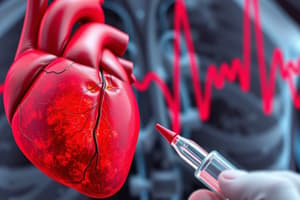Podcast
Questions and Answers
What is the ST segment?
What is the ST segment?
It is the interval between the end of ventricular depolarization (QRS complex) and the beginning of repolarization (T wave).
What does the ST segment represent?
What does the ST segment represent?
The interval between the end of ventricular depolarization (QRS complex) and the beginning of repolarization (T wave).
What is a segment?
What is a segment?
Areas of baseline between wave/complexes.
What is an interval?
What is an interval?
What is the J-point?
What is the J-point?
To find the J-point, locate the end of the QRS complex and identify the point where it makes a sudden or sharp change in direction; the point in which the QRS ends and the direction changes is the ______.
To find the J-point, locate the end of the QRS complex and identify the point where it makes a sudden or sharp change in direction; the point in which the QRS ends and the direction changes is the ______.
What should the ST segment be compared to, to determine elevation or depression?
What should the ST segment be compared to, to determine elevation or depression?
Why is determining the location of the J point critical to the diagnosis of ST segment elevation?
Why is determining the location of the J point critical to the diagnosis of ST segment elevation?
What is the TP segment?
What is the TP segment?
What is another way to identify the ST segment?
What is another way to identify the ST segment?
What is one setback to measuring the ST segment with reference to the TP segment as opposed to the PR segment?
What is one setback to measuring the ST segment with reference to the TP segment as opposed to the PR segment?
What is a normal ST segment?
What is a normal ST segment?
What are the ST segment morphologies?
What are the ST segment morphologies?
What is a nonspecific ST segment?
What is a nonspecific ST segment?
What is ST segment elevation?
What is ST segment elevation?
When the acute ischemia is transmural, what happens to the ST vector?
When the acute ischemia is transmural, what happens to the ST vector?
Profound ST elevation or depression in multiple leads usually indicates what?
Profound ST elevation or depression in multiple leads usually indicates what?
How is the division of acute myocardial infarction into ST-segment elevation and non-ST elevation types useful?
How is the division of acute myocardial infarction into ST-segment elevation and non-ST elevation types useful?
When ischemic ST elevations occur as the earliest sign of acute infarction, they typically are followed by what?
When ischemic ST elevations occur as the earliest sign of acute infarction, they typically are followed by what?
How do ST segment elevations associated with reversible transmural ischemia differ from those of acute infarction?
How do ST segment elevations associated with reversible transmural ischemia differ from those of acute infarction?
Flashcards are hidden until you start studying
Study Notes
ST Segment Overview
- The ST segment is the interval between the end of ventricular depolarization (QRS complex) and the beginning of repolarization (T wave).
- It is represented as a horizontal line along the baseline of the PR or TP intervals.
Segments and Intervals
- A segment refers to areas of baseline between waves/complexes.
- An interval includes segments plus the preceding waves/complexes.
J-Point
- The J-point marks the transition from the QRS complex to the ST segment, indicating the end of ventricular depolarization.
- Critical for identifying ST segment changes, essential in diagnosing conditions like myocardial infarction (MI).
Measuring ST Segment Changes
- Normal ST segment comparison is done from the PR segment to the ST segment at the J-point.
- ST segment elevation or depression indicates pathophysiological changes.
Importance of Accurate Measurement
- Accurate location of the J-point is crucial, as the criteria for elevation is 1 mm, impacting treatment eligibility for fibrinolytic therapy during MI.
TP Segment
- The TP segment is the interval from the end of the T wave to the beginning of the P wave.
ST Segment Identification
- The amount of ST segment elevation or depression is assessed relative to the TP segment and its morphology.
- Relying on the TP segment may lead to inaccuracies, particularly with negative P waves.
Normal ST Segment Characteristics
- Typically isoelectric, can range from 0.5 mm below to 1 mm above baseline in limb leads, and up to 3 mm elevation in precordial leads during early repolarization.
ST Segment Morphologies
- Different morphologies include concave upward, convex upward, horizontal, downsloping, and upsloping patterns.
Non-Specific Changes
- A nonspecific ST segment may show slight changes (< 1 mm) and does not indicate acute ischemia.
Measuring ST Elevation
- ST elevation should be measured at the Y point, specifically 40 ms from the J-point (J40).
Effects of Transmural Ischemia
- In cases of transmural ischemia, the ST vector shifts toward the epicardial layers, often resulting in ST elevations and hyperacute T waves.
Clinical Implications
- Profound ST elevation or depression across multiple leads typically suggests severe ischemia.
- Acute myocardial infarction is divided into ST-segment elevation and non-ST elevation types, guiding reperfusion therapy decisions.
Evolving ST Changes
- ST elevations occurring as acute infarction signs are followed by T-wave inversions and potential Q waves evolving over hours to days.
Reversible Ischemia vs. Acute Infarction
- ST segment elevations due to reversible transmural ischemia (e.g., coronary vasospasm) may resolve quickly and do not always lead to Q wave development.
Studying That Suits You
Use AI to generate personalized quizzes and flashcards to suit your learning preferences.




